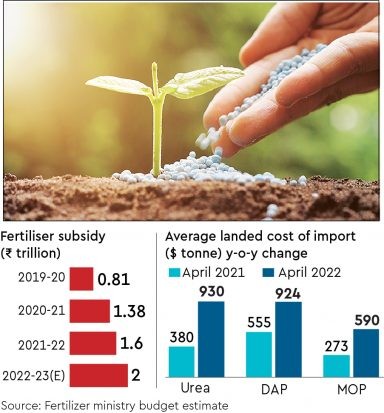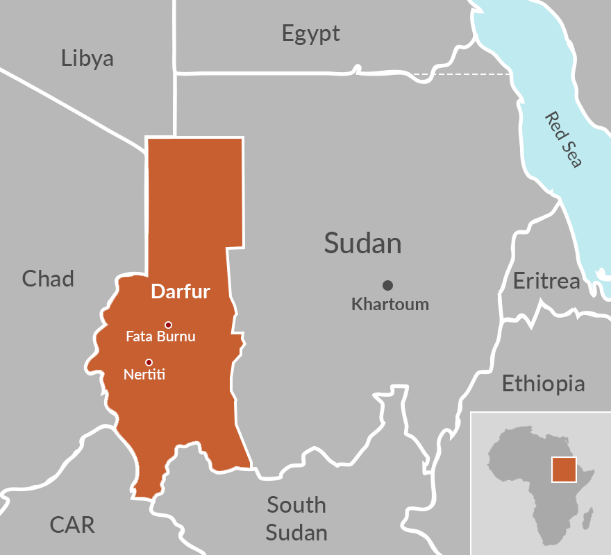Reforming India’s Food and Fertiliser Subsidies

- 25 Jun 2025
In News:
India’s food and fertiliser subsidy regime has played a critical role in ensuring food security and supporting farm productivity. However, with extreme poverty declining from 27.1% in 2011 to a historic low of 5.3% in 2022, and the combined food and fertiliser subsidy bill exceeding ?3.5 lakh crore in FY26, there is a growing policy imperative to reimagine these subsidies for greater efficiency, fiscal prudence, and long-term sustainability.
The Current Landscape
Food and fertiliser subsidies in India are a mix of direct and indirect support mechanisms. Direct subsidies include schemes like PM-KISAN, while indirect subsidies include low-cost foodgrains under the National Food Security Act (NFSA) and price-controlled fertilisers. As per government data:
- Food subsidy is budgeted at ?2.03 lakh crore, reaching over 800 million beneficiaries through the Public Distribution System (PDS).
- Fertiliser subsidy is pegged at ?1.56 lakh crore, driven by rising global prices and a skewed demand for urea.
Challenges in the Current Subsidy System
- Mismatch Between Poverty and Coverage: Despite poverty falling to 5.3%, 84% of households still possess ration cards, many of whom are no longer poor. This reflects poor targeting and leads to welfare leakages.
- Nutritional Deficiency in PDS: The PDS remains cereal-centric, primarily distributing rice and wheat, while nutrition insecurity persists due to insufficient supply of pulses, edible oils, and micronutrients.
- Fertiliser Misuse: The overuse of nitrogen-based fertilisers (particularly urea) has caused an ecological imbalance, deteriorating soil health and reducing long-term farm productivity.
- Fiscal Constraints: Massive subsidy expenditures are crowding out investments in rural infrastructure such as irrigation, cold storage, and extension services—critical for doubling farmer incomes.
- Leakages and Ghost Beneficiaries: Despite digitisation and Aadhaar seeding, leakages continue in both PDS and fertiliser channels, with instances like card cancellations in Jharkhand pointing to persistent inefficiencies.
Government Initiatives So Far
- PMGKAY during COVID-19 extended free foodgrains to NFSA beneficiaries, and has now been merged with NFSA provisions.
- Digitisation of ration cards and Aadhaar-enabled ePoS machines are being used to plug PDS leakages.
- Neem-coated urea and the Nutrient-Based Subsidy (NBS) policy aim to reduce misuse and promote balanced fertilisation.
- Direct Benefit Transfer (DBT) for fertilisers is being piloted to streamline subsidy flows and reduce diversion.
Reform Measures Needed
- Targeting and Gradation: Use PM-KISAN, SECC, and Aadhaar-linked databases to better identify the poorest 15% households and gradually taper subsidies for others.
- Digital Food Coupons: Introduce ?700/month digital wallets or coupons for nutrient-rich food purchases (pulses, eggs, milk), improving dietary diversity and nutrition security.
- Fertiliser Coupons & Price Rationalisation: Introduce fertiliser coupons, deregulate prices, and incentivise eco-friendly inputs like bio-fertilisers and organic compost.
- Improve Monitoring: Strengthen data triangulation using land records, crop surveys, and income data to reduce inclusion/exclusion errors.
- Farmer Sensitisation: Communicate the rationale for reforms clearly to farmers to avoid mistrust or resistance, as witnessed during earlier protests.
Conclusion
India’s welfare architecture must evolve with its changing socio-economic landscape. With poverty rates at historic lows, continued universal subsidies are both fiscally unsustainable and inefficient. Smartly targeted reforms in food and fertiliser subsidies are vital for improving nutritional outcomes, restoring soil health, and ensuring optimal allocation of public resources. A calibrated transition to a more efficient, inclusive, and sustainable system will enhance welfare delivery without compromising economic growth.
Regulation of OTT Content in India: Code of Ethics and Legal Framework

- 23 Feb 2025
In News:
The proliferation of Over-The-Top (OTT) platforms in India has transformed content consumption. However, rising concerns over obscene, vulgar, and explicit content have prompted the Ministry of Information & Broadcasting (I&B) to issue a fresh advisory urging adherence to the Code of Ethics under the Information Technology (Intermediary Guidelines and Digital Media Ethics Code) Rules, 2021 (IT Rules, 2021).
OTT platforms are digital streaming services that deliver content over the internet, bypassing traditional broadcasting. Their growing influence on public discourse, especially among youth, necessitates regulation.
Key Features of the Advisory
The advisory mandates strict compliance with the Code of Ethics under IT Rules, 2021:
- Prohibition of unlawful and obscene content.
- Age-based content classification and access control for ‘A’-rated content.
- A three-tier grievance redressal mechanism:
- Level I: Self-regulation by publishers.
- Level II: Oversight by self-regulatory bodies.
- Level III: Government oversight via I&B Ministry.
OTT platforms must also comply with:
- Indecent Representation of Women (Prohibition) Act, 1986
- Protection of Children from Sexual Offences (POCSO) Act, 2012
- Information Technology Act, 2000
- Bhartiya Nyay Sanhita, 2023
Recent Trigger: ‘India’s Got Latent’ Controversy
The advisory follows public outrage over vulgar remarks made by podcaster Ranveer Allahbadia on the YouTube show ‘India’s Got Latent’. The Supreme Court criticized the Centre for inadequate oversight of digital content and demanded legal action. The Parliamentary panel also sought a review of existing laws and possible amendments to strengthen content regulation.
Rationale for a Code of Ethics
- Protecting Minors: Shields children from harmful or explicit material.
- Preserving Public Decency: Prevents normalization of obscene content.
- Fostering Trust: Builds accountability and transparency in content curation.
Global Best Practices
- Ofcom (UK): Advocates age-verification, content classification, and proactive monitoring.
- European Audiovisual Observatory: Emphasizes transparency, regular audits, and self-regulation.
Implementation Challenges
- Enforcement gaps and inconsistent compliance across platforms.
- Vague definitions in the rules create interpretational ambiguities.
- Technological limitations in age verification and filtering mechanisms.
- Creative resistance from platforms fearing curbs on artistic freedom.
Way Forward
- Establish an independent content regulatory body for continuous oversight.
- Foster collaboration between government, platforms, and global agencies.
- Mandate regular content audits and public awareness campaigns.
- Incentivize ethical compliance through certifications and recognition.
Conclusion
While digital freedom is essential, unchecked content dissemination can erode societal values. The recent advisory underscores the need for a balanced regulatory approach—one that safeguards minors and public decency while respecting creative freedoms. A robust and dynamic Code of Ethics, coupled with technological upgrades and civic awareness, is key to building a safe and responsible digital media ecosystem in India.
Darfur Crisis: Humanitarian Emergency in Western Sudan

- 31 Jan 2025
Context:
Sudan’s Darfur region is once again in global focus following a deadly drone attack on the last functional hospital in El-Fasher, killing at least 67 people and injuring dozens. The International Criminal Court (ICC) has called for urgent UN Security Council intervention as the humanitarian situation deteriorates.
Geographical and Historical Background
- Location: Western Sudan, bordering Chad, Libya, Central African Republic, and South Sudan.
- Area: Approximately 493,000 sq. km, nearly the size of France.
- Topography: Predominantly arid and semi-arid terrain, with desert in the north and savanna in the south. Key physical features include:
- Jebel Marra Mountains: Volcanic highlands and key water source.
- Wadi Howar: Seasonal river vital for agriculture.
- Baggara Belt: Grazing zone, often contested.
- Historical Significance: Once an independent Islamic sultanate ruled by the Fur tribe, Darfur was annexed by Anglo-Egyptian Sudan in 1916. The name "Darfur" means "land of the Fur" in Arabic.
Ethnic Composition and Demographics
- Home to over 80 ethnic groups, including the Fur, Zaghawa, Beja, Nubians, and Arabs.
- Long-standing ethnic tensions exist between Arab nomadic groups and non-Arab farming communities, which have been a root cause of conflict.
Conflict Timeline and Key Actors
- Conflict Origins: Armed conflict began in 2003, led by rebel groups such as the Sudan Liberation Movement (SLM) and Justice and Equality Movement (JEM), demanding political autonomy and better representation.
- Government Response: The Sudanese government armed Janjaweed militias—now rebranded as the Rapid Support Forces (RSF)—who were accused of widespread atrocities, including genocide, mass killings, and rape.
- Recent Escalation:
- In 2023, violence surged amid civil war between Sudan's national army and RSF.
- RSF has seized much of Darfur and has besieged El-Fasher, capital of North Darfur, since May 2023.
- A January 2025 drone attack destroyed the Saudi Hospital in El-Fasher, killing 67 people. The hospital was one of the last with surgical capacity in the region.
Humanitarian Impact
- Health Crisis:
- 80% of healthcare facilities in Sudan are non-functional.
- Attacks on medical infrastructure have been rampant; El-Fasher’s Saudi Hospital was hit multiple times by suspected RSF drones.
- Displacement and Starvation:
- Over 12 million people displaced.
- Tens of thousands killed.
- Famine has already gripped camps like Zamzam, Abu Shouk, and Al-Salam, and is expected to spread to additional regions, including El-Fasher, by May 2025 (UN Assessment).
Global and Regional Implications
- The Darfur conflict has destabilized the region, affecting neighboring countries like Chad and the Central African Republic.
- ICC has issued warrants for several individuals including former President Omar al-Bashir, citing war crimes and crimes against humanity.
- The conflict highlights the intersection of climate stress, ethnic rivalries, political marginalization, and international accountability failures.
India Has the Highest Cases Of TB in The World: Global TB Report 2023 (NDTV)

- 09 Nov 2023
Why is it in the News?
According to the Global TB Report 2023 by the World Health Organisation, India had the highest number of Tuberculosis (TB) cases in the world in 2022.
What is the Global Tuberculosis Report?
- The Global Tuberculosis Report published by the World Health Organisation (WHO).
- It provides a comprehensive and up-to-date assessment of the TB epidemic and progress in prevention, diagnosis, and treatment of the disease at global, regional, and country levels.
- This is done in the context of global TB commitments, strategies, and targets.
- This report is based primarily on data gathered by WHO from national ministries of health in annual rounds of data collection.
Key Findings of the Global Tuberculosis Report 2023?
- India had the highest number of Tuberculosis (TB) cases in the world in 2022.
- The country accounted for 27 percent of the total TB cases in the world.
- The report revealed that 30 nations accounted for 87 percent of the world's TB cases.
- India was followed by Indonesia (10 per cent), China (7.1 per cent), the Philippines (7.0 per cent), Pakistan (5.7 per cent), Nigeria (4.5 per cent), Bangladesh (3.6 per cent), and the Democratic Republic of Congo (3.0 per cent).
- In the Case of the Fatality Ratio (the measure of how severe a disease is), India stood at 12 percent, which means 12 out of 100 patients died of the disease.
- Singapore had the lowest score of 1 percent while China stood at the 14th spot with 4 percent.
- While TB is curable, death can occur when it is diagnosed late.
- The report also highlights a recovery trend in TB diagnosis and treatment services in 2022, signaling a potential reversal of the COVID-19 impact on TB control efforts.
What is Tuberculosis (TB)?
- Tuberculosis (TB) is an infectious disease primarily caused by the bacterium Mycobacterium tuberculosis.
- It mainly affects the lungs but can also impact other parts of the body such as the pleura (lining around the lungs), lymph nodes, intestines, spine, and brain.
- Transmission:
- TB spreads through the air when an infected person with active TB disease coughs, sneezes, or even talks.
- The bacteria can travel through the air and be inhaled by people who are nearby.
- Symptoms:
- Common symptoms include a persistent cough lasting three weeks or more, chest pain, unintentional weight loss, fatigue, and fever.
- The symptoms may develop gradually, making early detection crucial.
- Treatment for TB:
- TB is treated with a course of antibiotics, typically lasting six to nine months.
- It's crucial to complete the full course to ensure the bacteria are completely eradicated and to prevent drug resistance.
- Prevention:
- Prevention involves vaccination with the Bacillus Calmette-Guérin (BCG) vaccine, particularly in regions with high TB prevalence.
- Avoiding close contact with infected individuals helps prevent transmission.
- Drug-resistant TB:
- Drug-resistant TB occurs when the TB bacteria in a person's body don't respond to, or are resistant to, one or more of the primary TB drugs.
- There are two main categories of drug-resistant TB:
- MDR (multidrug-resistant) TB and
- XDR (extensively drug-resistant) TB.
- MDR TB is characterized by bacteria resistant to at least two vital TB drugs, isoniazid and rifampicin. These drugs are among the most effective in treating TB.
- On the other hand, XDR TB takes resistance a step further. In addition to being resistant to isoniazid and rifampicin, XDR TB strains are also resistant to any fluoroquinolone and at least one of three injectable second-line drugs: amikacin, kanamycin, or capreomycin.
- This makes XDR TB more challenging to treat, as it doesn't respond to a broader range of medications commonly used against TB.
- The World Health Organization's END TB Strategy, initiated in 2014, sets a goal to globally eradicate the TB epidemic by 2035.
- The strategy targets a 95% reduction in TB-related deaths compared to 2015, a 90% decrease in TB incidence rates by 2035 compared to 2015, and the ambitious aim of ensuring that no families face catastrophic costs due to TB by the year 2035.
Global Initiatives to Combat Tuberculosis:
- The World Health Organization (WHO), in collaboration with the Global Fund and Stop TB Partnership, has introduced the joint initiative "Find. Treat. All. #EndTB."
- The release of the Global Tuberculosis Report by WHO serves as a crucial tool in assessing and addressing the global TB situation.
Initiative by Government of India to Tackle Tuberculosis:
- National TB Elimination Programme: Prioritizing TB elimination by allocating additional resources under the National Health Mission, intensifying efforts towards achieving the goal of a TB-free India.
- Ayushman Bharat Digital Health Mission: It emphasizes the integration of technology by introducing digital health IDs for TB patients.
- This initiative aims to guarantee the availability of accurate diagnostics and appropriate treatment through digital means.
- Pradhan Mantri TB Mukt Bharat Abhiyan: It's an initiative of the Ministry of Health and Family Welfare (MOHFW) to accelerate the country’s progress towards TB elimination by 2025.
- Ni-kshay Poshan Yojana: It provides Rs 500 support through direct benefit transfer to eligible patients.
- Currently, two vaccines VPM (Vaccine Projekt Management) 1002 and MIP (Mycobacterium Indicus Pranii) have been developed and identified for TB, and are under Phase-3 clinical trial.
Way Forward
- Specialized Active Case Finding Drives: Launch targeted campaigns to actively identify and diagnose TB cases in specific populations.
- Scaling Up of Molecular Diagnostics to Block Levels: Expanding the use of molecular diagnostic techniques to the grassroots level for efficient and accurate TB detection.
- Decentralization of Screening Services through Ayushman Bharat Health & Wellness Centres: Extending screening services to local health and wellness centers under the Ayushman Bharat initiative, making TB detection more accessible.
- Private Sector Engagement: Collaborating with the private sector to enhance TB case identification and treatment.
- Newer Patient-Centric Initiatives: Introducing innovative models like the Family Caregiver Model and Differentiated Care to reduce mortality and improve treatment success rates.
